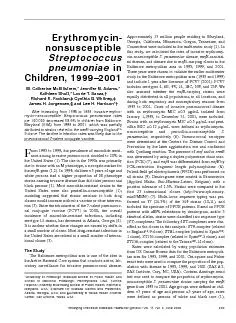

the United States 1 The rise in the 1990s was primarilyUnited States were also penicillinnonsusceptible 1 gmLisolated from STcomplexes The following 4 STcomplexes were clas 5 years of ag ID: 841856
Download Pdf The PPT/PDF document "ErythromycinStreptococcusChildren1999200..." is the property of its rightful owner. Permission is granted to download and print the materials on this web site for personal, non-commercial use only, and to display it on your personal computer provided you do not modify the materials and that you retain all copyright notices contained in the materials. By downloading content from our website, you accept the terms of this agreement.
1 Erythromycin-StreptococcusChildren,1999
Erythromycin-StreptococcusChildren,19992001M. Catherine McEllistrem,* Jennifer M. Adams,*Kathleen Shutt,* Laurie T. Sanza, Richard R. Facklam, Cynthia G. Whitney,After increasing from 1995 to 1999, invasive erythro-Streptococcus pneumoniaeMaryland (USA) from 1999 to 2001, which was partially the United States (1). The rise in the 1990s was primarilyUnited States were also penicillin-nonsusceptible (1); g/mLisolated from (ST)-complexes. The following 4 ST-complexes were clas- 5 years of age; raceswere defined as persons of white and black race (1); Emerging Infectious Diseases www.cdc.gov/eid Vol. 11, N
2 o. 6, June 2005969 *University of Pittsb
o. 6, June 2005969 *University of Pittsburgh Graduate School of Public Health andSchool of Medicine, Pittsburgh, Pennsylvania, USA; JohnsAtlanta, Georgia, USA; and §University of Texas Health ScienceCenter, San Antonio, Texas, USA by 54.6% (p = 0.04; Table). Strains related to the EnglandE-associated disease stabilized. The proportion of2001. The increase in the proportion of erythromycin-non-years of age. This decrease was partially due to serotype 14-9 clone. Strains related tomacrolide-resistant serotype 14 infections noted in Atlanta(4). In contrast to the Atlanta study, the rates of 5 years. The dif-fer
3 ences in rates detected in Baltimore com
ences in rates detected in Baltimore compared to Atlantathe Atlanta analysis (4). In this study, the decrease in theIn summary, after increasing in the 1990s, the rates ofto 2001. This remarkable decline was most likely due toPCV7, although differential antimicrobial drugs may havebeen a contributor. Unfortunately, the lack of decline in the 5 years of age, coupled withthe marked increase in dual resistance and the increase inthe proportion with erythromycin MICs � g/mLfromAcknowledgmentsWe thank the participating hospital infection control practi-providing the microbial isolates; Yvonne Deane-Hibbert,
4 JackieHunter, Carolyn Wright, and Tami H
JackieHunter, Carolyn Wright, and Tami Hilger Skoff for assistance incollection; Althea Glenn Laboratories administration for pro-Letitia Fulcher, and Christa Trippy for the antimicrobial suscep-tibility determinations; and Anne Schuchat for her cogent reviewConference on Emerging Infectious Diseases in Atlanta, Georgia,This work was supported in part by the State of Maryland,the Centers for Disease Control and Preventions Emerging Streptococcus pneumoniae Emerging Infectious Diseases www.cdc.gov/eid Vol. 11, No. 6, June 2005971 county, season, race, and age group.pAnneson (p = 0.02 for those comparisons